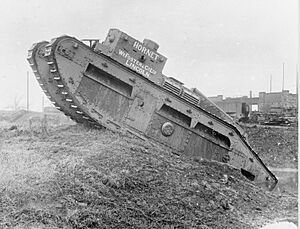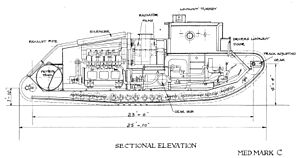Medium Mark C facts for kids
Quick facts for kids Medium Tank Mark C |
|
|---|---|

The Medium Mark C tank, also known as the Hornet
|
|
| Type | Medium tank |
| Place of origin | United Kingdom |
| Production history | |
| Designer | William Rigby |
| Designed | 1917 |
| Manufacturer | Fosters |
| Produced | 1918 (August–November) |
| No. built | 50 |
| Specifications ('Female' (This version had machine guns)) | |
| Mass | 20 long tons (20 t) (about as heavy as 3 big elephants!) |
| Length | 25 ft 10 in (7.87 m) |
| Width | 8 ft 4 in (2.54 m) |
| Height | 9 ft 6 in (2.90 m) |
| Crew | 4: commander, driver, mechanic, machine gunner |
|
|
|
| Armour | 14 mm (0.55 in) maximum (its protective metal skin) |
|
Main
armament |
5 x .303 (7.7mm) machine guns |
| Engine | Ricardo 6-cylinder petrol engine 150 hp (110 kW) |
| Power/weight | 7.5 hp/tonne (power-to-weight ratio, a measure of how zippy it was) |
| Suspension | unsprung (no springs, so a bumpy ride!) |
|
Operational
range |
225 km (75 miles) (how far it could go on one tank of fuel) |
| Maximum speed | 7.9 mph (12.7 km/h) (around 12.7 km/h) |
| References | Fletcher 2001, White |
The Medium Mark C Hornet was a British medium tank. It was designed during the First World War (1914-1918). But, guess what? It was finished just a bit too late to actually join in the battles of that war.
Contents
How Was the Hornet Tank Created?
Back in 1917, during World War I, two tank designers, Sir William Tritton and Major Walter Gordon Wilson, used to work together. But then, Tritton designed a tank called the Medium Mark A Whippet all by himself.
A Friendly Rivalry
Major Wilson might have felt a bit left out. So, he started designing his own new tank, the Medium Mark B, in July 1917. When Tritton found out, he told his top designer, William Rigby, to create an even better tank – and that became the Medium Mark C! It was like a design competition between them.
The British Army liked Rigby's plans for the Mark C. They gave their approval on April 19, 1918. The first working model, called a prototype, was ready in August. This was just a few weeks before Major Wilson's Medium B prototype was finished. Funnily enough, both prototypes were built at Tritton's own factory!
Big Plans, Few Tanks
The army initially wanted 200 Mark C tanks. Then they increased their order to 600! They were all going to be made by a company called William Foster & Co Ltd in Lincoln. Another company, Armlet & Wortley, was going to help. But in the end, because the war ended, only 50 were actually built.
The tank was supposed to have the nickname "Hornet," but it seems that name never really caught on with people.
What Did the Hornet Look Like?
At first glance, the Medium C looked a bit like its competitor, the Medium B. Both had that classic diamond shape of early tanks like the Mark I. They also had a fixed, armored room at the front called a casemate. This room had mounts for five machine guns. These mounts were like ball joints, so the guns could be aimed in different directions.
Bigger and Better
But Tritton's Medium Mark C was quite a bit longer than the Medium B. Like the Medium B, it had a separate engine room at the back. However, the Mark C's engine room was bigger. It could fit a powerful 6-cylinder Ricardo petrol engine (like a car engine, but much bigger!). This engine was behind a special gearbox, similar to the one used in the big Mark V heavy tanks. Chains connected the gearbox to the sprockets that turned the tracks.
A cool feature was that the crew could easily get to the engine from their fighting area if something needed fixing. Because of its bigger engine, the Mark C was faster than some other tanks, reaching speeds of about 7.9 mph (12.7 km/h) (around 12.7 km/h). Being longer also meant it was much better at crossing wide trenches dug by soldiers on the battlefield. It had a big fuel tank that could hold 150 imp gal (680 L) of petrol. This gave it a good range of about 140 mi (230 km) (around 225 km) before needing to refuel. So, it could move around the battlefield much more easily.
Designed for the Crew
Mr. Rigby, the designer, really thought about the soldiers who would use the tank. He tried to make it as comfortable and easy to use as possible:
- The tank commander had a special rotating lookout tower (called a cupola) to see all around. He even had a small map table!
- There were eleven small slits for the crew to look out of, giving them a good view while staying protected.
- Special boxes were built in for the crew of four (commander, driver, mechanic, and machine gunner) to keep their personal belongings.
- They used speaking-tubes, like old-fashioned intercoms, to talk to each other inside the noisy tank.
- The driver even had an odometer to measure how far they had traveled.
Did the Hornet See Any Action?

The army had big plans for the Medium C. They thought another tank they were developing, the Medium Mark D, might not be ready for mass production in 1919. So, the Tank Corps (the part of the army that used tanks) hoped to get as many as 6,000 Medium Cs that year!
"Male" and "Female" Tanks
About one-third of these planned tanks were going to be a "Male" version. In World War I, "Male" tanks were those that carried cannons, while "Female" tanks usually just had machine guns. This "Male" Medium C would have had a long six-pounder (57 mm) gun at the front of its superstructure. This was the same type of gun used on the very first British tanks. Drawings were made for this version, but it was never actually built. The 50 tanks that were made were all "Female" versions with machine guns.
War Ends, Orders Cancelled
When World War I ended in November 1918, all the big orders for the Medium C were cancelled. Only 36 tanks were nearly finished at that point. These were completed, and another fourteen were built from parts that had already been made. So, in total, only 50 Medium C tanks were ever built.
General J.F.C. Fuller, an important tank expert, thought about using money planned for developing the Medium D tank to build more Medium Cs instead. He wanted all the regular, peace-time tank battalions (groups of tanks) to have this newer, better tank. But, in the end, he decided against it. So, only one group, the 2nd Tank Battalion, received the Medium C tank.
Kept Safe and Sound
Because the Medium C was the newest and most modern tank the Tank Corps had, they were very careful with them. They didn't want them to get damaged or lost.
- No Medium Cs were sent to Russia to help fight in the Russian Civil War (a war that happened in Russia after World War I).
- None were sent to Ireland during the Anglo-Irish War (a conflict between Britain and Ireland).
- The only time most people saw them was when four Medium Cs took part in the big victory parade in London in 1919, celebrating the end of World War I.
A Show of Force in Glasgow
The only "action" these tanks ever saw was a bit unusual and didn't involve any fighting. In 1919, there were big protests and some unrest in the city of Glasgow, Scotland. This event became known as the Battle of George Square. Some Medium C tanks were sent to Glasgow and parked in a place called the Cattle Market. They were there just in case they were needed to help control the crowds and restore order, but they were never actually used.
The End of the Hornet
From 1925 onwards, the Medium C tanks were gradually replaced by newer and better tanks, like the Medium Mark I and Medium Mark II. There were some ideas to turn the old Medium Cs into recovery vehicles (like tow trucks for tanks), but these plans were rejected. One single Medium C was used for a while to test a new type of transmission (gearbox).
Sadly, by 1940, during World War II, the very last remaining Medium C tank was melted down. This often happened to old metal equipment so the metal could be used to build new weapons or other things needed for the war.


